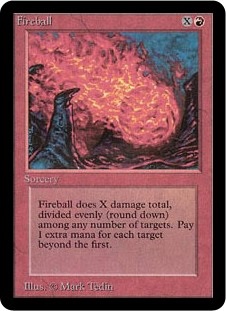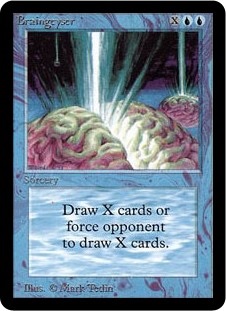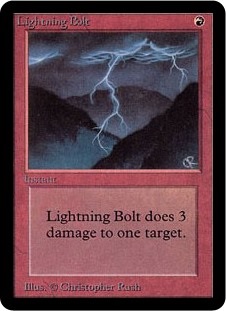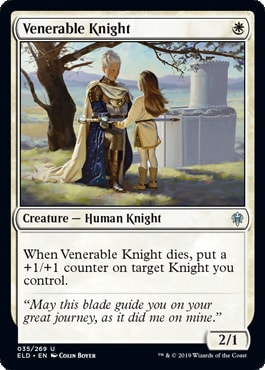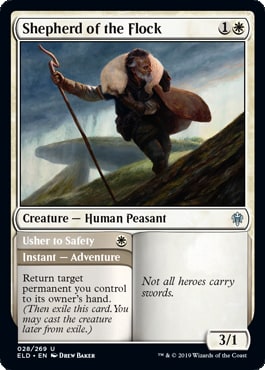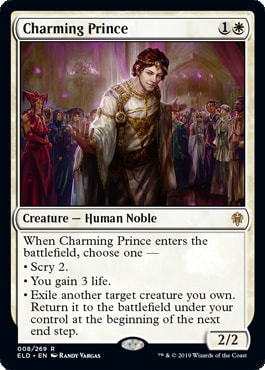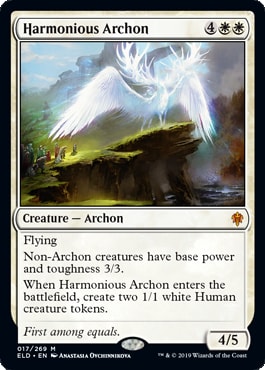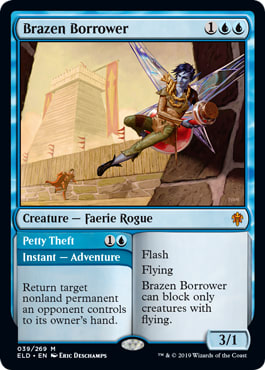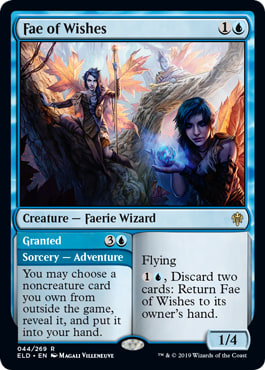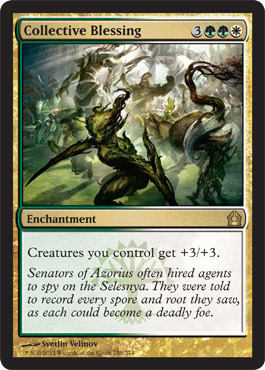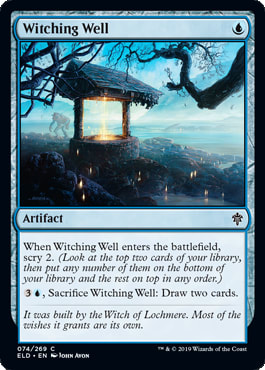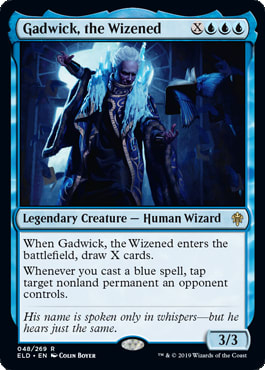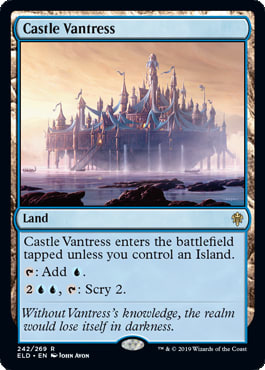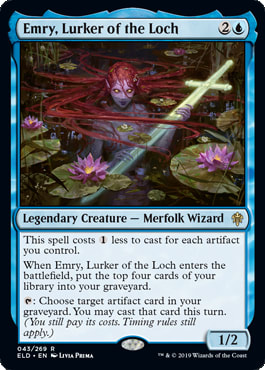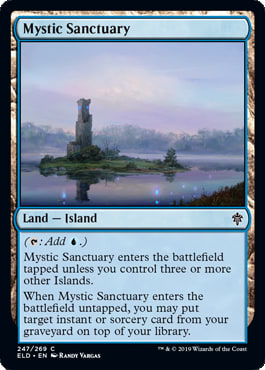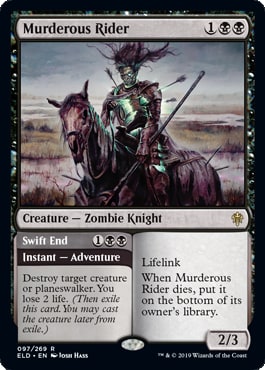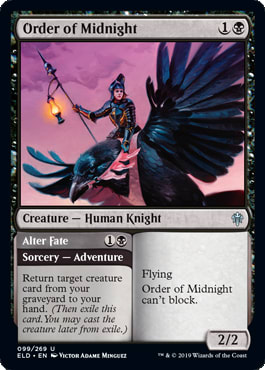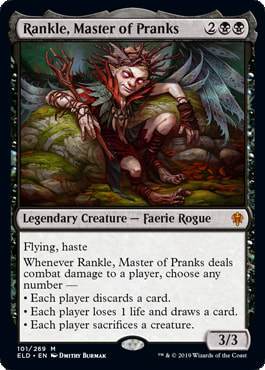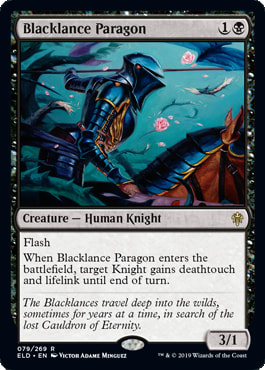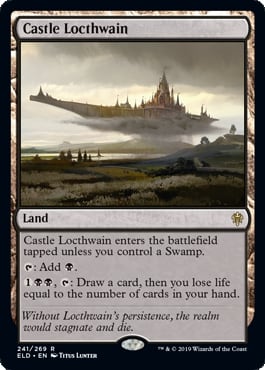DISCLAIMER: This article will be citing spoiled cards which have been tested in Cube from Theros: Beyond Death. Consider this your spoiler warning!
2019 has brought us a bevy of Cube-heavy sets and Throne of Eldraine continues this trend to wrap up the year. Let's go into how it does that.
As usual, these evaluations are based on actual Cube experience from several months' worth of Cube drafts in various Cubes that'll be referenced in this article and discussion from other Cube drafter's experiences on the MTG Cube Brainstorming discord, where I spend a good chunk of my Cube time these days. It's not just outsourced to other formats; I've always worked to have my reviews to have cards go through the ringer with many Cube reps and with it being this long after the set came out, this review has more data than other reviews that I've done. The decks referenced have used Throne of Eldraine cards and either went 3-0 or had the best record in their respective Cube drafts.
I'll be referencing which Cubes these 3-0 decks came from in the article, since they came from several Cubes. Of course, going 3-0 with a card in a deck isn't ironclad proof of that card being good, but it does help illustrate how the card performs in Cube decks. Cards are sorted in order of approximate interest by color - the ones that pique my interest for Cube discussed first in approximate order and if a card isn't discussed here, it's intentionally so. I'll briefly touch upon the Cube cards from Commander 2019 and Game Night 2019 as these sets that featured a lot of misses but a few hits for Cube.
Skip to
White
Realm-Cloaked Giant (and Adventures in General)
There's an old joke that every keyword is kicker and when I looked through the various mechanics across the years1 , a lot can be seen as riffs on kicker. What sets adventure apart is that it's one of the few mechanics with more than 2 modes:
Spell only (with the creature mode never used), Creature only, Both modes used.
Evoke and Flashback come close in terms of overall function, but few come close to the flexibility provided. Shortly after Throne of Eldraine came out, Brian Gottlieb pointed out how adventure cards have been underrated on the Arena Decklists podcast episode around the 14 minute mark:
At this point, the cat's out of the bag for the obviously pushed ones like Murderous Rider, Bonecrusher Giant, and Brazen Borrower. But at least for Cube, overall reception has been muted on adventure cards outside of this obvious trio (and maybe Embereth Shieldbreaker). Realm-Cloaked Giant is a good example of one of those that have been underrated, since its non-wrath mode isn't like the upsides on other ![]()
![]()
![]() wraths that we've seen.
wraths that we've seen.
Modal cards have been with us since the beginning.
Generally, when cards like Fireball and Stroke of Genius (which typically sees more Cube play than Braingeyser) see play in Cube, they're mainly as glorified kill spells as something to do as a wincon for making gobs of mana. Every once in a while, they'll be cast for a smaller amount to draw a few cards or to kill a problematic creature, but they're rarely used outside of endgame mode. Due to their relative inefficiency, they don't see a lot of Cube play, whereas not seeing Lightning Bolt in a Cube would raise some eyebrows.
Once bitten, twice shy, as the saying goes. We saw similar mental shortcutting with Risk Factor as it's a card that was dogged as being bad due to an assumption that all cards that give an opponent a choice are bad, as opposed to that being a drawback (one which made most punisher cards bad, but not Risk Factor.)
It's easy to assume that a lot of these modal cards are bad - Hydroid Krasis, for example, is a recent example of a card that was underrated because it looked like a "bad Mulldrifter" on its various spots on the mana curve: "Why would I pay ![]()
![]()
![]() for a wonky flying Coiling Oracle/
for a wonky flying Coiling Oracle/![]()
![]()
![]() for a Mulldrifter" without taking into consideration how useful modality is for these kinds of cards. There isn't a convenient shorthand for quantifying how much that's worth. Of course, not all adventure cards are winners - like Garenbrig Carver, but there's a lot more winners than losers for the adventure mechanic in Cube.
for a Mulldrifter" without taking into consideration how useful modality is for these kinds of cards. There isn't a convenient shorthand for quantifying how much that's worth. Of course, not all adventure cards are winners - like Garenbrig Carver, but there's a lot more winners than losers for the adventure mechanic in Cube.
In previous articles, I've talked about how flexible cards generally need to have a good "base rate" for doing something that Cube decks want. This is because even if it's not at the most efficient rate, performing a goal *effectively* is key - think of Finale of Glory, which is good at ![]()
![]()
![]() and can scale up, compared to the other Finale cards in War of the Spark which don't really have a good "base rate" at which to cast them. Due to the three modes on adventure cards, it's a bit more complicated than that, but it's not a bad place to start.
and can scale up, compared to the other Finale cards in War of the Spark which don't really have a good "base rate" at which to cast them. Due to the three modes on adventure cards, it's a bit more complicated than that, but it's not a bad place to start.
The well for 4-mana Mono-White wraths runs dry after Day of Judgment, Wrath of God, and Settle the Wreckage. Beyond these, you need to start dipping into multiple colors to run the likes of Supreme Verdict.
As a 5-mana wrath, Realm-Cloaked Giant's adventure mode trades the residual lifegain upside of Fumigate, the ability to be an instant of Rout, and the ability to be a Purify with Cleansing Nova with the ability to either be a 7/7 vigilance or to be "flashed back" as one. Because it's easy to quantify the approximate value of the old standbys, and it's not as easy to quantify how much mana it's worth to be able to cast a seven-Mana 7/7 or to have that mode as a kicker, it's easy to dismiss this mode as worthless. While it can't protect itself, requires tapping a lot of mana on main phase, and is a clunky finisher, you paid the admission cost of drawing it upfront, so those factors aren't as prescient as on a card where it's the entire card. Usually, I found that because the cost difference between Cast Off and Realm-Cloaked Giant was low, usually decks that were playing it were able to play both halves, unless the player is on death's door.
As a general note about control: ever since the inception of Planeswalkers, control decks have relied less on "traditional" control finishers such as Keiga, the Tide Star since planeswalkers were able to do double duty of being card advantage machine and finisher. While Realm-Cloaked Giant doesn't have any of the premium qualities that finishers of old have (ways to protect itself, abilities like Lifelink, resiliency against spot removal), I found that sometimes all that you need is a giant beatstick once the dust settles, and he's done a great job there. This control deck comes courtesy of Sirfunchalot's Cube:
Cube Test Deck #1 | Cube | Sirfunchalot
- Creatures (4)
- 1 Curator of Mysteries
- 1 Jace, Vryn's Prodigy
- 1 Realm-Cloaked Giant
- 1 Vendilion Clique
- Planeswalkers (4)
- 1 Ashiok, Nightmare Weaver
- 1 Elspeth, Sun's Champion
- 1 Elspeth, Sun's Nemesis
- 1 Sorin, Lord of Innistrad
- Instants (6)
- 1 Brainstorm
- 1 Logic Knot
- 1 Opt
- 1 Power Sink
- 1 Ultimate Price
- 1 Worldly Counsel
- Sorceries (9)
- 1 Damnation
- 1 Languish
- 1 Migratory Route
- 1 Omen
- 1 Oust
- 1 Ruinous Path
- 1 Sleight of Hand
- 1 Sunlance
- 1 Supreme Verdict
- Enchantments (2)
- 1 Domestication
- 1 Prison Realm
- Lands (15)
- 1 Swamp
- 3 Island
- 3 Plains
- 1 Creeping Tar Pit
- 1 Hallowed Fountain
- 1 Polluted Delta
- 1 Windswept Heath
- 2 Godless Shrine
- 2 Watery Grave
(No, that's not a typo, that's the Theros: Beyond Death Elspeth, which we've been testing out in Cube since it was spoiled.)
With this type of game plan in mind, one can fully see the power of an on-rate wrath effect that can be used to finish a game when needed. Pixels wrote a great article about using hypergeometric to evaluate how often effect types come up in a Cube. While it may be tempting to just take out another wrath to put this in, take some time to read that article and find out if the density of mass removal is being reached in your Cube, as I've found it to be a great wrath variant for Cube.
Giant Killer - Earlier, I talked about how the three modes on adventure cards muddy the waters for base mode analysis. Because of this, there isn't an easy answer to how to quantify what is "good enough" for most of these Cubeable adventure cards where a specific mode is an obvious mode A (like the ![]()
![]()
![]() wrath mode on Realm-Cloaked Giant, or the
wrath mode on Realm-Cloaked Giant, or the ![]()
![]()
![]() Hero's Downfall mode on Murderous Rider), but the general adage of base rate still applies... to a point. It's more about base function with these, since it's easy to fall into the evaluative trap of dismissing a card because it appears weak on its adventure mode and creature mode.
Hero's Downfall mode on Murderous Rider), but the general adage of base rate still applies... to a point. It's more about base function with these, since it's easy to fall into the evaluative trap of dismissing a card because it appears weak on its adventure mode and creature mode.
One of the great things that I've found with adventure cards is that they help to address an annoyance with aggro decks - it's easy for quality non-creature spells to sit in the sideboards in aggro decks since those non-creature slots get stressed, as the aggro gameplan requires having many cheap creatures to enact your gameplan, putting non creature slots at a premium, usually comprising removal, ways to boost creatures and generically powerful cards.
Giant Killer's Reprisal mode isn't efficient, and it's a Fan Bearer when cast. Both parts, unlike Realm-Cloaked Giant, look weak on their own. But much like how Hydroid Krasis isn't just a bad Mulldrifter at ![]()
![]()
![]() , I've found that being able to be a cheap creature, a removal spell, or a way to keep a creature tied up in one card, has made Giant Killer a solid performer in aggro decks as a way to deal with creatures.
, I've found that being able to be a cheap creature, a removal spell, or a way to keep a creature tied up in one card, has made Giant Killer a solid performer in aggro decks as a way to deal with creatures.
In the War of the Spark review, I talked about Law-Rune Enforcer and how it's the best tapper in Cube and whether or not you think Law-Rune Enforcer is better than Gideon's Lawkeeper - as they're all pretty close in overall power - I've found Giant Killer's flexibility to put it over the top of the others. If you've discounted this on initial glance, give it a shot in your Cube.
Venerable Knight - It's a 2/1 for ![]() with a small ability that hardly ever was relevant. The choice to include it is entirely based on how much you want to support your aggressive decks. Much like Falkenrath Gorger, do not let the additive distraction fool you as a 2/1 for
with a small ability that hardly ever was relevant. The choice to include it is entirely based on how much you want to support your aggressive decks. Much like Falkenrath Gorger, do not let the additive distraction fool you as a 2/1 for ![]() is a great aggro statline.
is a great aggro statline.
Shepherd of the Flock's obvious analog is to other 3/1s for two, like Accorder Paladin and Glory-Bound Initiate. Much like Giant Killer, I've found that the sum of its parts make it great for Cube and make it much better than these aforementioned creatures.
There's been some precedent with "gating" creatures like Stonecloaker and Whitemane Lion seeing scant Cube play; generally these were more combat trick than creature, since they were useless without something to rescue and couldn't reliably be used to curve out. That made these creatures problematic for aggressive decks to include, since they are purely reactive spells and only rarely can be used to advance the clock by bouncing a creature and then replaying the rescued creature. So why care about Shepherd of the Flock and its adventure mode?
While Rescue and gating creatures on their own are weak for aggro decks, having the *option* of being able to rescue your own creatures, I've found, is an incredibly useful option to have for aggro decks.
My podcast co-host Anthony Avitollo wrote an article about combat tricks and why they generally don't make the grade in Cube by talking about how spot removal hurts these kinds of effects.
However, I found spot removal wasn't the entire reason, as I've had some decent success with some combat tricks in rarity-restricted Cubes, where mass removal is significantly worse than Wrath of God and Toxic Deluge - think Pestilence + Pyrotechnics in Pauper and Drown in Sorrow + Breath of Darigaaz in peasant - mass removal that isn't anywhere near as reliable as what we're used to with rares. I found that mass removal was a significant part of the story, which makes sense since you can't buff a creature if they're all dead, making your Giant Growth rot in your hand, contributing nothing.
Since aggro decks used every part of the buffalo as the saying goes, when a card was stuck in hand that wasn't contributing towards the aggro game plan, this meant your other cards had to carry you harder to victory, or you're going to lose - and usually the latter happened.
Shepherd's adventure mode isn't a combat trick that keeps a creature attacking through a removal spell, like how Vines of Vastwood does, because the rescued creature is going back to the hand. Although this may look like it's bad for aggro, since it stops a damage source, usually your aggressive creatures are cheap enough to deploy on the second main phase, and doing something like attacking, bouncing your threat that was about to get Doom Bladed, and then play it and the 3/1. There were some nice scenarios that I didn't see when I saw the card, like being able to bounce your own planeswalker that's being attacked and would die or as a way to use a walker ability, and then bounce it and play it again and then use the ability again, although the former happened *much* more than the latter.
Recall the classic Mark Rosewater Kavu Titan story:
During my last match, Randy watched. At some point late in one of the games, I played my Grizzly Bears. After the match was over, Randy informed me that the Grizzly Bears weren't actually Grizzly Bears. They were proxies for Kavu Titan. Armed with this information, the next week I went 2-2. Suffice to say that the R&D guys thought this was the funniest thing ever. The lesson I learned was the importance of using the Kavu Titans as 2/2s. When I was aggressive with Kavu Titan, my deck performed much better. When I waited to maximize the Kavu Titans as 5/5 creatures, I lost much of the aggression of my deck and thus some of its power. Week 3, I went 4-0 again."
It's easy to fall into the trap of not casting it on curve, overly valuing trying to extract value out of a card, which is doubly erroneous in aggro since your deck is trying to kill the opponent ASAP. The whole of Shepherd's parts hasn't been absurd, but it's a solid performer for aggro decks.
Faerie Guidemother's adventure mode, being a sorcery, isn't a combat trick, but it is a way to push damage through when the ground gets stalled, while also being a creature that isn't breaking efficiency records, but does go along with the aggro game plan. While a 1/1 flier for one may look anemic for aggro's gameplan, its various modes allow it to be much more than a simple Suntail Hawk and I've been a fan of it for Cube as it's been a great performer for White aggro decks like this in my Cube: (my list online is extremely out of date, even in spite of constant updates to the actual list ,although the list, overall, hasn't changed much in a macro sense.)
Cube Test Deck #2 | Cube | Usman Jamil
- Creatures (15)
- 1 Adanto Vanguard
- 1 Archangel Avacyn
- 1 Dauntless Bodyguard
- 1 Faerie Guidemother
- 1 Flickerwisp
- 1 Giver of Runes
- 1 Icehide Golem
- 1 Isamaru, Hound of Konda
- 1 Law-Rune Enforcer
- 1 Leonin Relic-Warder
- 1 Precinct Captain
- 1 Recruiter of the Guard
- 1 Shepherd of the Flock
- 1 Skymarcher Aspirant
- 1 Vryn Wingmare
- Planeswalkers (3)
- 1 Gideon Blackblade
- 1 Gideon of the Trials
- 1 Gideon, Ally of Zendikar
- Instants (1)
- 1 Path to Exile
- Sorceries (3)
- 1 Council's Judgment
- 1 Ravages of War
- 1 Winds of Abandon
- Artifacts (1)
- 1 Smuggler's Copter
- Lands (17)
- 15 Snow-Covered Plains
- 1 Horizon Canopy
- 1 Wasteland
Silverflame Squire - Unlike Shepherd of the Flock, when evaluating the "base rate", a 3/1 for two is considered fine for 2019 creature standards while a 2/1 for two is pretty close to a D grade. We've seen some riffs on Goblin Piker + combat trick, like Skinbrand Goblin, which suffered because if used as a trick, it couldn't be used for anything else. However, I've found that the times where the combat trick allows your tapped creature to untap and ambush an attacker are usually huge tempo swings, especially if you follow by adding a body to the board, and was usually fine as a plan B if it just needed to be cast as just a White Goblin Piker.
Also, because players usually don't expect combat tricks in Cube, the sudden burst damage can help White-based aggro clean up a game. This effect may wear off if these non-obvious adventure cards see high Cube adoption rates and/or if these kinds of cards become more of a known quantity in a Cube that's consistently drafted, changing the question from "what could the opponent possibly have?" to "does the opponent have it?" That being said, paying ![]()
![]() for a combat trick is expensive and there were times that it was a problem to use, since it'd Time Walk you when used, but again, this usually just came down to knowing when to bite the bullet and cast it.
for a combat trick is expensive and there were times that it was a problem to use, since it'd Time Walk you when used, but again, this usually just came down to knowing when to bite the bullet and cast it.
All of the aforementioned liabilities of combat tricks still apply, but I've found that during the early game, players are less likely to hold up removal, as they're trying to commit to the board and it's been an aggro creature that's impressed in testing and as heretical as it may sound, I've found it several degrees of quality better than 2nd-string 2-drops like Glory-Bound Initiate for Cube.
Castle Ardenvale - I've found this castle, along with the others in this set, to be solid inclusions in Mono- and two-color Cube decks that didn't have extremely awkward mana costs (think Cryptic Command and cards with a ![]()
![]() cost in the same deck.) In my experience, these hardly came into play tapped and others who have been testing the set have said similarly. A cost of
cost in the same deck.) In my experience, these hardly came into play tapped and others who have been testing the set have said similarly. A cost of ![]()
![]()
![]() and tapping the land in order to make a creature looks atrocious when compared to cards like Karakas, which do their thing without requiring mana input.
and tapping the land in order to make a creature looks atrocious when compared to cards like Karakas, which do their thing without requiring mana input.
However, I found that when the deck with Castle Ardenvale got to the late game, it was one of the better mana sinks available by using unspent mana at the end of the opponent's turn to create a 1/1 token if the game got there. This type of effect is best in midrange and control decks, but coming untapped means that even aggro decks can slot it and use it to grind versus the control decks if the game state gets that far, without sacrificing their early game.
The castle is certainly better than Kjeldoran Outpost, and it's been performing decently as a White utility land. Its inclusion mainly depends on whether you have room or are willing to use a card slot for it and ultimately, the choice is yours if you feel that it's worth the Cube slot for something that isn't as overtly powerful as other cards, even something generic like a Journey to Nowhere. If, for some reason, you have to choose between Karakas and this, Karakas is the better card (but don't limit yourself for like-for-like changes) but Castle Ardenvale has been solid as a second-stringer.
Ardenvale Tactician - I found that the creature side was reasonable for aggro decks (albeit not spectacular) as an evasive threat, and its adventure mode helps the aggro decks get midrange's beefy blockers out of the way for an alpha strike, an axis that generally isn't represented in Cube very often. It creates a way to push through burst damage on a board that looks stabilized for the opponent, which was relevant for the aggro vs midrange matchup. This type of card exemplifies the beauty of adventures: the individual pieces are *reasonable*, but together allow the player to play on both the card advantage AND tempo axes. The package overall was pretty good for White aggro decks, but hardly a staple.
Charming Prince - When asking what the "base mode" is for this charmer, it's easiest to compare it to its closest former Cube analogue: Lone Missionary. The Missionary's position used to be in non-aggressive decks, where the lifegain was irrelevant to the deck's gameplan. It's been overrated but also not terrible; finding it lacking in Cube decks that had it in their final 40 and usually didn't do enough for the mana, even in spite of flexibility.
As for the elephant in the room: the hype for this card has been from its function in the "blink" micro archetype, where it serves as both an enabler and payoff. However, in decks that weren't going deep on blink (it isn't really a supported archetype in my Cube, since I've found it's generally a gameplan that isn't worth its slots), even though giving the options of lifegain or scrying in addition to blinking something if the stars aligned, I found that it wasn't enough to make an otherwise vanilla 2/2 worth a card. At least with the adventure cards, the ceiling is higher, and the floor not too different. If you're in the market for another blink card, you don't need me to charm you on the prince, but don't expect this to be a Cube-all star in decks outside of that archetype, because I found that it wasn't.
Harmonious Archon - Wizards is very good at making cards that look better than they play, and Archon is yet another in this vein. While the promise of a flying body that brings two 3/3s is enticing as a big Cloudgoat Ranger-style creature, how good the card is largely depends on your opponent's board and found that sometimes the opponent goes wider than you, turning Archon into a huge liability. The dream scenario is if it's on a board where there's not much on the opponent's side, if the opponent can't interact with it and riding the archon to victory, but that's a lot of ifs to ask for when other high-cost White finishers don't ask those same questions. The fail case being two 1/1s makes this substantially worse than most army in a can creatures, putting the Archon squarely into Baneslayer territory. While that alone should not be cause to dissuade you, the potential for board stats where the card is uncastable should.
Blue
Brazen Borrower is this set's Disperse with upside, essentially acting as Into the Roil/Blink of an Eye but a kicker that the caster has more control over - one that isn't locked in when cast. Generally it wasn't cast as a ![]()
![]()
![]() flash flier without having bounced something first, and although it may seem like Blue control decks aren't in the market for a creature that can't block, usually those decks found it fine as a "free" way to close out the game once the dust settled when all that's needed is a ham sandwich to beat the opponent down and as a way to hold up mana for several turns while having something else to do if the opponent doesn't have anything worthy to counter, like cards like Think Twice in pauper U/B Teachings. Here's how Brazen Borrower manifests itself in Cube, courtesy of SirFunchalot's Cube:
flash flier without having bounced something first, and although it may seem like Blue control decks aren't in the market for a creature that can't block, usually those decks found it fine as a "free" way to close out the game once the dust settled when all that's needed is a ham sandwich to beat the opponent down and as a way to hold up mana for several turns while having something else to do if the opponent doesn't have anything worthy to counter, like cards like Think Twice in pauper U/B Teachings. Here's how Brazen Borrower manifests itself in Cube, courtesy of SirFunchalot's Cube:
Cube Test Deck #3 | Cube | Sirfunchalot
- Creatures (7)
- 1 Brazen Borrower
- 1 Gadwick, the Wizened
- 1 Innocuous Insect
- 1 Murderous Rider
- 1 Night Incarnate
- 1 Shriekmaw
- 1 The Scarab God
- Planeswalkers (4)
- 1 Gideon, Ally of Zendikar
- 1 Kaya, Ghost Assassin
- 1 Mu Yanling, Sky Dancer
- 1 Teferi, Hero of Dominaria
- Instants (7)
- 1 Counterspell
- 1 Go for the Throat
- 1 Impulse
- 1 Mana Leak
- 1 Swords to Plowshares
- 1 Syncopate
- 1 Truth or Tale
- Sorceries (5)
- 1 Preordain
- 1 Serum Visions
- 1 Shimmer of Possibility
- 1 Wrath of God
- 1 Yahenni's Expertise
- Enchantments (1)
- 1 Domestication
- Artifacts (1)
- 1 Witching Well
- Lands (15)
- 1 Plains
- 1 Swamp
- 2 Island
- 1 Arid Mesa
- 1 Ash Barrens
- 1 Bloodstained Mire
- 1 Celestial Colonnade
- 1 Creeping Tar Pit
- 1 Evolving Wilds
- 1 Scrubland
- 2 Tundra
- 2 Underground Sea
Fae of Wishes's 1/4 flier for two lines up well against a typical Cube meta - as a virtual wall vs aggro or a bolt-proof way to peck against walkers and although one wouldn't think a ![]()
![]() flier gets cast often in Cube, it was used much more often than one would think since having four toughness was huge and found that it wasn't bad as a "kicker" after wishing for something.
flier gets cast often in Cube, it was used much more often than one would think since having four toughness was huge and found that it wasn't bad as a "kicker" after wishing for something.
A common argument I've seen Fae's wish mode is that you usually put the best cards in your deck, meaning that your wish target is going to be worse than the wish card. There is some merit - a lot of the "wish" cards (if using your sideboard, per sanctioned rules) failed to make a mark in Cube because they usually didn't have enough of a toolbox.
Think back to Core Set 2020's Vivien, Arkbow Ranger. She has a "wish" mode, but her main modes are pumping dorks, a la Ajani, and punching things, but having an ultimate that occurs rarely is par for the course for planeswalkers. However, when it does matter, it's usually very good as a way to get a wide variety of options for whatever's in play, even if it's not as efficient as options that are in the final 40.
Those non-creature cards are... not very good in Cube. But given the board state, some of these greta garbos can be better than anything that's in your deck, given the game state. Maybe you're in a board jam and need something to go over the top of the opponent. Maybe you need an answer to an opposing horde. While these cards are objectively weak and aren't up to snuff in your bog standard Cube, having these kinds of options to pull out of a hat for ![]()
![]() is a nice thing to have, especially if they're "free" late picks that enhance your toolbox. If you think of how useful it is in that scenario, think of this in a Cube that's running cards that would fit at home on a Cube power level.
is a nice thing to have, especially if they're "free" late picks that enhance your toolbox. If you think of how useful it is in that scenario, think of this in a Cube that's running cards that would fit at home on a Cube power level.
Fae of Wishes's wish mode also shines when you have cards you would like to cast, but cannot do so reliably. As an example, a ![]()
![]() -splashing
-splashing ![]() deck might run enough Red sources to cast its single-pip splash burn, but it cannot guarantee double Red, so a Chandra, Torch of Defiance has to sit in the sideboard. But, if at some point you do gain access to
deck might run enough Red sources to cast its single-pip splash burn, but it cannot guarantee double Red, so a Chandra, Torch of Defiance has to sit in the sideboard. But, if at some point you do gain access to ![]()
![]() , suddenly wishing for her becomes an option and may be better than whatever else is in your deck. Also, there is something to be said about decks which pack off-color mana sources to begin with, like having a Tundra as a free White source in an Izzet deck to play a Wished Swords to Plowshares or using it as a way to bluff a splash that's in the final 40 if the opponent hasn't seen the Fae of Wishes, but that's likely just Fancy Play Syndrome.
, suddenly wishing for her becomes an option and may be better than whatever else is in your deck. Also, there is something to be said about decks which pack off-color mana sources to begin with, like having a Tundra as a free White source in an Izzet deck to play a Wished Swords to Plowshares or using it as a way to bluff a splash that's in the final 40 if the opponent hasn't seen the Fae of Wishes, but that's likely just Fancy Play Syndrome.
Depending on your Cube, you might find some cards that simply don't make the final cut for being too narrow, or antithetical to your game plan, but perfect for a specific scenario.
My friend Zolthux recalls a story when testing it in his Cube, where he was on Grixis control. He had a reanimate in the sideboard because he was concerned about the life loss in a deck that ran multiple life payment cards. During one particular game, he traded his entire board of tokens with the opponent's Carnage Tyrant. He used Granted to get Reanimate, cast it, and targeted the Tyrant.
Finally, it is also worth noting that if your Cube has less "parasitic" cards, the viability of your wish targets increases, as your sideboard may have more cards like Searing Spear instead of something more linear like Empty the Warrens or Sulfuric Vortex, and even the ability to get a basic land from the sideboard has had some niche uses. The Cube Cats podcast had a great pilot talking about how parasitism can manifest in Cube, and the talk is especially topical with these cards.
Usually, Fae of Wishes was in tempo and control decks like this, courtesy of Sirfunchalot's Cube:
Cube Test Deck #4 | Cube | Sirfunchalot
- Creatures (9)
- 1 Brazen Borrower
- 1 Brimaz, King of Oreskos
- 1 Fae of Wishes
- 1 Gadwick, the Wizened
- 1 Giant Killer
- 1 Hypnotic Sprite
- 1 Restoration Angel
- 1 Student of Warfare
- 1 Vendilion Clique
- Planeswalkers (2)
- 1 Jace, Architect of Thought
- 1 Mu Yanling, Sky Dancer
- Instants (8)
- 1 Censor
- 1 Clash of Wills
- 1 Miscalculation
- 1 Path to Exile
- 1 Rune Snag
- 1 Swords to Plowshares
- 1 Telling Time
- 1 Truth or Tale
- Sorceries (4)
- 1 Chart a Course
- 1 Oust
- 1 Preordain
- 1 Treasure Cruise
- Artifacts (2)
- 1 Heirloom Blade
- 1 Witching Well
- Lands (15)
- 3 Plains
- 5 Island
- 1 Fabled Passage
- 1 Flooded Strand
- 1 Marsh Flats
- 1 Misty Rainforest
- 3 Tundra
The sideboard was unknown, but likely nothing too out of the ordinary.
It's been a great add for Blue decks and although Blue's a hard nut to crack in Cube, I've found that it has what it takes to get there.
Witching Well - The Cube Cats podcast called it by saying Witching Well was actually a great card months ago, and it's been a solid card in my Cube.
Of course, this compares oddly to other cantrips, because it doesn't immediately draw a card, needing additional mana input and sacrificing itself to Weave Fate. That doesn't make it a bad cantrip, it just makes it different than your usual Serum Visions style card.
Much like Serum Visions, this sets up early draws; and, although library manipulation without card advantage is usually not a recipe for success, there are some exceptions.
It acts like somewhat of a link between both halves of Hieroglyphic Illumination, or Courier's Capsule, where you get something when it's cast and then you're able to cash it in for value later in the game. Much like adventure cards, I found it's greater than the sum of its parts. These kinds of effects are generally underrated, and Theros: Beyond Death's Omen of the Sea looks to continue this trend as reception for it has been, for the most part, muted, in comparison to how well it's been playing out.
Hypnotic Sprite - Unlike Brazen Borrower, the creature half lacks flash, which puts it at odds with itself as a counterspell, especially in decks that want to play an EOT game against their opponent. What it usually meant was the caster had to be a bit more careful on when to cast it - and for the ![]()
![]() cost, I found it wasn't hard to cast it and hold up protection mana in the late game. The CMC restriction hasn't mattered a whole lot, and it's played somewhat like Exclude-meets-Abrupt Decay that draws a 2/1.
cost, I found it wasn't hard to cast it and hold up protection mana in the late game. The CMC restriction hasn't mattered a whole lot, and it's played somewhat like Exclude-meets-Abrupt Decay that draws a 2/1.
All in all, this type of adventure is very skill testing as sometimes it is worth holding on to the counter, but sometimes you are able to run out the 2/1 flier to pressure the opponent/their planeswalkers early. It's another card that I haven't seen a lot of hype for but I've been impressed with in my Cube.
Gadwick, the Wizened - First Cavalier of Gales and now this? Wizards must really want us to stop playing Mulldrifter, eh? In my testing, I have found Merlin (not to be confused with the most adorable Siamese cat) to be decent as a ![]()
![]()
![]()
![]() creature that draws 2 cards on ETB and as a mana sink for the late game, the latter of which is something that's easy to disregard. Much like with adventure cards, usually it was a skill-tester to know when to cast this late vs. getting a Trained Armodon, but when the time's right, the time's right.
creature that draws 2 cards on ETB and as a mana sink for the late game, the latter of which is something that's easy to disregard. Much like with adventure cards, usually it was a skill-tester to know when to cast this late vs. getting a Trained Armodon, but when the time's right, the time's right.
Even the ability to tap things was surprisingly useful to close the game out. The base rate seems to be at around five mana because of how hard the four mana mode is to cast on curve, a la Cryptic Command. The second mode gets better if you follow Xerox theory and overload your deck with cantrips (and you should!) While it loses out on blink potential, I've overall liked how it's played compared to the old guard like Mulldrifter and other 5-mana finishers, especially since there've been times when it just refuels the hand and then runs away with the game due to the gained card advantage. If, for some reason, you think this needs devotion to be a good Cube card, please reconsider your assumptions.
Corridor Monitor is a Twin combo piece primarily. Being an artifact creature is mostly a liability as it dies to Shatters, but it's not like Pestermite or Zealous Conscripts are the most resilient threats in the world for their mana costs. That said, those creatures at least have some kind of function outside of the combo, but at their heart, they're primarily Twin pieces and thus parasitic to the Twin archetype. This isn't necessarily a bad thing, but don't fool yourself into thinking this'll see play in a Blue control deck unless it's coming in from the sideboard against the aggro matchup as it lines up excellently against the Savannah Lions variants of the world.
Inclusion in your Cube mainly depends on if you want another card that interacts with Kiki-Jiki, Mirror Breaker and Splinter Twin, since that's its primary home - and secondarily as an aggro hoser, but is much worse at that role than Fae of Wishes. Combo style decks like Kiki-Twin aren't looking to replace one of their combo pieces since I've found that it's worse than the flashy old guard, as Pestermite and Splinter Twin were able to play around removal. These decks are looking to maximize combo pieces, not simply replace them, as all critical mass decks want to do (like aggro's early drops) for consistency, so inclusion mainly depends on that.
Castle Vantress - Much like with Castle Ardenvale, this didn't enter the battlefield tapped very often. In theory, it allowed blue control decks to hold up countermagic and something to do if the opponent didn't have anything to counter, but I found that in most Cube matches, there weren't these kinds of scenarios that often. It is a "free" slot, and usually it was better than an Island in a Cube deck, since the cost of admission was so low, but the cost of a Cube slot in a color as great as blue was the more prohibitive factor. All in all, it wasn't bad, but hardly necessary.
Emry, Lurker of the Loch - I can probably count the number of times that I've seen cards like Frogmite and Myr Enforcer in a Cube, and that's probably because I'm the only person who I've personally seen try them out in a Cube (not just Pauper) environment. The issue with a lot of relying on the affinity for artifact discount was that they usually require having a significant number of artifacts in a deck, like enough to reliably trigger metalcraft in density, and a lot of Cubes just don't have that unless it's in a deck like signet/talisman tribal decks.
Even with that experience, I was reticent to try out Emry but figured I'd do so for completeness sake and she never did that much. She was usually cast as a 1/2 for ![]()
![]() which is a decent rate, but the problem with her artifact recast was what I had expected - her ability works best with artifacts like Black Lotus/Lion's Eye Diamond, artifacts that sacrifice themselves, and artifact creatures, since they're a threat that the opponent has an incentive to deal with, and so you're able to bring it back.
which is a decent rate, but the problem with her artifact recast was what I had expected - her ability works best with artifacts like Black Lotus/Lion's Eye Diamond, artifacts that sacrifice themselves, and artifact creatures, since they're a threat that the opponent has an incentive to deal with, and so you're able to bring it back.
Emry's been overrated for Cube because those best-case scenarios, reminiscent of cards like Auriok Salvagers, a card that was deemed "too good" for Cube in early Cubes (oh, how far we've come,) but the average cases weren't that great, since it was usually to bring back an artifact creature that died or something that got shattered - more insurance policy than combo engine - and it just wasn't that great of a payoff for including her in your stock blue Cube deck.
Mystic Sanctuary - despite how broken it appeared as a land that worked with blue's game plan, I found that Mystic Sanctuary came into play tapped more often than not and usually was a bad Island. The card has seen some success in eternal formats, showing that the power is there, but it does require a very heavy commitment to blue, and unlike cards like Vedalken Shackles, in Cube, this wasn't a good payoff for going into super-heavy blue and didn't make much of an impact.
Black
Murderous Rider is an obviously absurd card that somehow exceeded my initially high impressions. This was mainly from the life loss usually not being too relevant and how useful a Blind Phantasm with lifelink was as a body that lined up well with the format by outsizing 2/2s and usually being able to turn the corner if it's on a board where it can attack uncontested, either as a 2/3 for 3 or, more often, as a way to use excess mana once your board control's been deployed.
Don't be lazy and swap Hero's Downfall or another premium removal for this, as your Cube likely is in the market for *more* of these, not a predetermined number that can't be disrupted for fear of disrupting your Cube's feng shui. Do your homework and find a better cut.
Order of Midnight - There aren't a lot of good Raise Dead effects in Cube and Gravediggers, and as such it seemed like Order of Midnight didn't get a fair shake out of the gates. We also don't tend to see a lot of 2/X fliers in black either, as cards like Vampire Interloper isn't a common Cube sight these days. Must be bad, right? Not at all!
While a lot of previous adventures don't have an obvious mode A and work because of the inherent flexibility of their 3 modes, I found that Order of Midnight was more often than not cast as a flying Gravedigger for ![]()
![]()
![]() .
.
This was where the card usually found itself, like this deck from my Cube:
Cube Test Deck #5 | Cube | Usman Jamil
- Creatures (15)
- 1 Bomat Courier
- 1 Bonecrusher Giant
- 1 Falkenrath Gorger
- 1 Fervent Champion
- 1 Firedrinker Satyr
- 1 Goblin Guide
- 1 Goblin Rabblemaster
- 1 Hangman
- 1 Hexdrinker
- 1 Kari Zev, Skyship Raider
- 1 Monastery Swiftspear
- 1 Mother of Runes
- 1 Order of Midnight
- 1 Rakdos Cackler
- 1 Stoneforge Mystic
- Planeswalkers (2)
- 1 Chandra, Acolyte of Flame
- 1 Garruk Relentless
- Instants (6)
- 1 Galvanic Blast
- 1 Kolaghan's Command
- 1 Lightning Bolt
- 1 Slaughter Pact
- 1 Snuff Out
- 1 Swords to Plowshares
- Artifacts (1)
- 1 Grafted Wargear
Although this is a weird mishmash, the point more so is that Black-base aggro (either heavy or two-color) is where Order of Midnight shined best.
That being said, it saw more play in non-aggro than expected, as I had expected its inability to block to be a prohibitive liability for those decks, but it was still fine in decks like midrange. It was also nice, in those decks, to be able to have a 2-mana flying beatstick if the player smelled blood in the water and wanted to end the game ASAP. The Kavu Titan story applies here as well, and Zolthux, much like myself, has found that it's usually the right call to play Order of Midnight on turn two if it's in the opening hand - at least in aggro.
Even the Raise Dead mode found itself being used, despite being overcosted by card cost standards, because sometimes it was just the right call to make and it's also just nice to have these kinds of insurance policies in Cube decks. Overall, I've been very impressed.
Rankle, Master of Pranks is like Black's Hellrider equivalent as a curve topper. While cards like Nekrataal and Skinrender have a more obvious immediate impact on the game, I've found that all of Rankle's modes have been useful in aggro. Those decks usually are able to get hellbent or have cannon fodder to sacrifice, and being able to craft what Rankle can do based on the board state made its connection trigger very good. With its discard/draw modes, in a counterintuitive way, I found that it helped to snowball its advantage by stopping potential answers to it or increasing your clock.
Usually, non-aggro decks weren't able to utilize the symmetrical discard as much and was less good than the standby Nekrataals as a result. However, it was hardly embarrassing in the final 40 of those decks since it was able to pressure planeswalkers and life totals effectively due to having haste and flying. If you don't mind a card for four that's mostly aggro-leaning in your Black section, give Rankle a shot.
Blacklance Paragon usually played as a Doom Blade meets Lightning Helix on defense and as a 3/1 with flash to attack the next turn secondarily, but this may have been due to playing it too conservatively. Much like with Shepherd of the Flock, although we don't tend to see many Blade of the Sixth Pride variants in Cube, I've found this to be one of the better ones, especially since it has flash to surprise attackers and defending planeswalkers.
If you're not playing Black aggro in your Cube, it loses a good chunk of its value as having a 3/1 ground attacker without evasion doesn't line up with the gameplan of non-aggro Black, usually, and it usually wasn't good when it was played in those styles of decks. But for Black aggro, I was impressed by its Cube performance - don't be fooled into thinking that this requires a "knight theme" in your Cube, as it's solid in Black aggro as the only knight in a deck.
Foulmire Knight is another card that I've seen underrated for Cube because the Pharika's Chosen style of creature is very underrated in Cube, aside from representing Ophiomancer tokens. It's mainly been seeing play as an aggro 1-drop since cards like Pharika's Chosen aren't what non-aggro decks are looking for, even if it does help to stonewall attackers. Although I don't care about how these creatures play later in the game, I found it nice that it was able to effectively cycle later in the game or dig for something earlier in the game.
Over the years, I've frequently heard Cube designers poo-poo on Black aggro, but usually when doing so, they fail to play to its strengths of disruption and removal. Foulmire Knight isn't something like the underrated Mesmeric Fiend/Brain Maggot team, but by being able to trade up easily, I've found it, in a roundabout way, to be disruption by gaining tempo. Admittedly, this may be a stretch and decks that have used it well mainly just wanted to attack with it and maybe give it some buffs to make blocking it harder. Decks like this from my Cube, for example:
Cube Test Deck #6 | Cube | Usman Jamil
- Creatures (14)
- 1 Dark Confidant
- 1 Figure of Destiny
- 1 Foulmire Knight
- 1 Giant Killer
- 1 Icehide Golem
- 1 Isamaru, Hound of Konda
- 1 Kitesail Freebooter
- 1 Knight of the Holy Nimbus
- 1 Monastery Mentor
- 1 Shepherd of the Flock
- 1 Skymarcher Aspirant
- 1 Stoneforge Mystic
- 1 Thalia, Guardian of Thraben
- 1 Thraben Inspector
- Planeswalkers (2)
- 1 Gideon Blackblade
- 1 Serra the Benevolent
- Sorceries (1)
- 1 Lingering Souls
- Enchantments (1)
- 1 Legion's Landing
As we all know, aggressive decks are, by their very nature, critical mass decks that want a critical mass of beaters. They don't care as much if they're Bloodsoaked Champion levels of pushed, they mainly just need to attack and falcon punch the opponent to death. I've found this to do a great job at that.
Castle Locthwain played about as well as expected as a card that helps to refuel Black aggro decks when they're low on gas - much like Foulmire Knight. It saw some play in non-aggro black decks since the opportunity cost of putting it in a deck was so low, but it almost never activated in decks that would have 3+ cards in their hand, so it essentially was a basic swamp there. The same spiel about the opportunity cost for a Cube slot applies here, doubly so since it's essentially a black aggro slot, and it's likely better served by another cheap creature.
Wishclaw Talisman - much like Scheming Symmetry, this is excellent in a combo deck that wants to kill the opponent soon after casting it and terrible outside of it. You at least get 2 uses, but in an "unfair" deck, the opponent doesn't get a turn to use it. Artifact removal may increase the chances for it to make the final 40 of a deck outside of combo but that's still really loose. Much like cards like Cabal Ritual, consider this a purely combo card.
Piper of the Swarm was fine as filler to hold the fort as a ? that could do something with fallow mana, but I found it to be a bit too mana-intensive for the cost. In theory, it allows decks like UB to hold up either countermagic or rat mana, but it wasn't worth the cost of a card. Unsurprisingly, it never stole anything either.
Stay tuned for part 2 of this review coming out tomorrow, featuring red, green, artifacts and a few assorted goodies from Commander 2019 and Game Night 2019!
1 Kicker/Multikicker, Entwine, Escalate, Bestow, Awaken, Buyback, Cycling, Forecast, Fuse, Level-Up, Living Weapon (kinda), Morph, Overload, Outlast (kinda), Retrace, Monstrosity, Adapt, Replicate, Evoke, Transmute. I'm sure that I'm missing some.

















